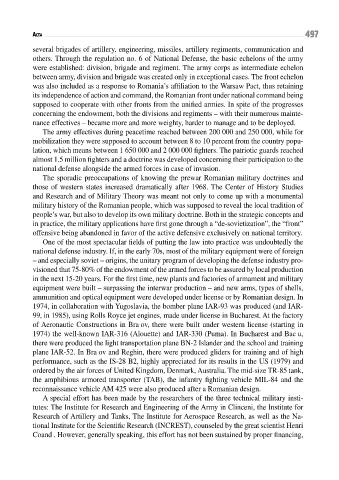Page 497 - Conflitti Militari e Popolazioni Civili - Tomo I
P. 497
497
aCta
several brigades of artillery, engineering, missiles, artillery regiments, communication and
others. Through the regulation no. 6 of National Defense, the basic echelons of the army
were established: division, brigade and regiment. The army corps as intermediate echelon
between army, division and brigade was created only in exceptional cases. The front echelon
was also included as a response to Romania’s affiliation to the Warsaw Pact, thus retaining
its independence of action and command, the Romanian front under national command being
supposed to cooperate with other fronts from the unified armies. In spite of the progresses
concerning the endowment, both the divisions and regiments – with their numerous mainte-
nance effectives – became more and more weighty, harder to manage and to be deployed.
The army effectives during peacetime reached between 200 000 and 250 000, while for
mobilization they were supposed to account between 8 to 10 percent from the country popu-
lation, which means between 1 650 000 and 2 000 000 fighters. The patriotic guards reached
almost 1.5 million fighters and a doctrine was developed concerning their participation to the
national defense alongside the armed forces in case of invasion.
The sporadic preoccupations of knowing the prewar Romanian military doctrines and
those of western states increased dramatically after 1968. The Center of History Studies
and Research and of Military Theory was meant not only to come up with a monumental
military history of the Romanian people, which was supposed to reveal the local tradition of
people’s war, but also to develop its own military doctrine. Both in the strategic concepts and
in practice, the military applications have first gone through a “de-sovietization”, the “front”
offensive being abandoned in favor of the active defensive exclusively on national territory.
One of the most spectacular fields of putting the law into practice was undoubtedly the
national defense industry. If, in the early 70s, most of the military equipment were of foreign
– and especially soviet – origins, the unitary program of developing the defense industry pro-
visioned that 75-80% of the endowment of the armed forces to be assured by local production
in the next 15-20 years. For the first time, new plants and factories of armament and military
equipment were built – surpassing the interwar production – and new arms, types of shells,
ammunition and optical equipment were developed under license or by Romanian design. In
1974, in collaboration with Yugoslavia, the bomber plane IAR-93 was produced (and IAR-
99, in 1985), using Rolls Royce jet engines, made under license in Bucharest. At the factory
of Aeronautic Constructions in Bračov, there were built under western license (starting in
1974) the well-known IAR-316 (Alouette) and IAR-330 (Puma). In Bucharest and Bacču,
there were produced the light transportation plane BN-2 Islander and the school and training
plane IAR-52. In Bračov and Reghin, there were produced gliders for training and of high
performance, such as the IS-28 B2, highly appreciated for its results in the US (1979) and
ordered by the air forces of United Kingdom, Denmark, Australia. The mid-size TR-85 tank,
the amphibious armored transporter (TAB), the infantry fighting vehicle MIL-84 and the
reconnaissance vehicle AM 425 were also produced after a Romanian design.
A special effort has been made by the researchers of the three technical military insti-
tutes: The Institute for Research and Engineering of the Army in Clinceni, the Institute for
Research of Artillery and Tanks, The Institute for Aerospace Research, as well as the Na-
tional Institute for the Scientific Research (INCREST), counseled by the great scientist Henri
Coandč. However, generally speaking, this effort has not been sustained by proper financing,

